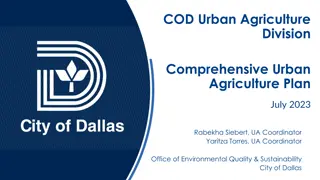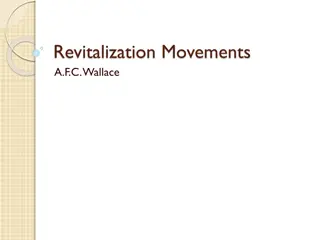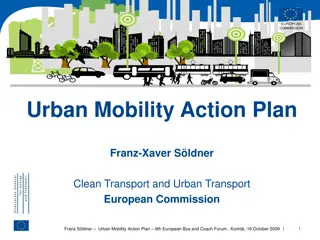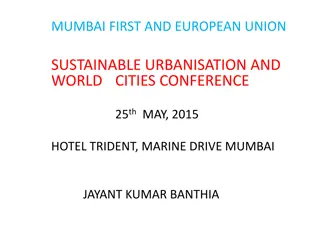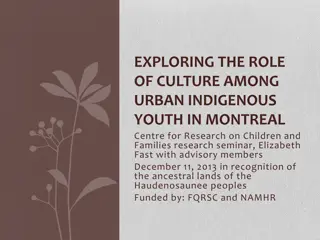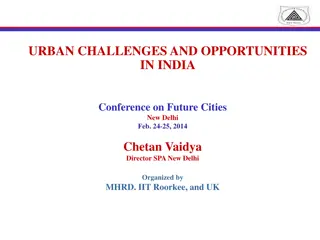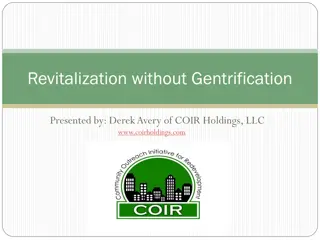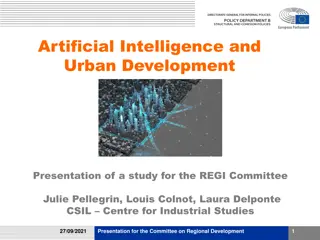Cultural Development Strategies and Urban Revitalization
The use of cultural activities and facilities in urban revitalization, the significance of cultural development strategies in economic plans, and the rise of cultural strategies following deindustrialization and growth of service industries. Explore how local governments in the US implement cultural strategies and prioritize activities for economic development.
Download Presentation

Please find below an Image/Link to download the presentation.
The content on the website is provided AS IS for your information and personal use only. It may not be sold, licensed, or shared on other websites without obtaining consent from the author.If you encounter any issues during the download, it is possible that the publisher has removed the file from their server.
You are allowed to download the files provided on this website for personal or commercial use, subject to the condition that they are used lawfully. All files are the property of their respective owners.
The content on the website is provided AS IS for your information and personal use only. It may not be sold, licensed, or shared on other websites without obtaining consent from the author.
E N D
Presentation Transcript
CULTURAL DEVELOPMENT STRATEGIES AND URBAN REVITALIZATION Carl Grodach & Anastasia Loukaitou Sideris 12 Nov 2007
The use of cultural activities and facilities to bolster a city s image, attract tourism, and foster economic development has become widespread (museums, concert halls, performing arts centers, galleries) Cultural development strategies have acquired significance in the economic development plans of cities
the bulk of the research focuses on Western Europe and evaluates the success of specific cultural projects in urban regeneration The current literature lacks, however, a comparative analysis of how local governments in the US develop and implement cultural strategies. three types of cultural strategies Entrepreneurial Strategies Creative Class Strategies Progressive Strategies
then present the results of a survey which explores the perspectives, motivations, and goals of representatives from Departments of Cultural Affairs in large and medium-sized US cities. to determine the extent to which municipalities consider cultural activities as mechanisms for economic development and helps us gain an understanding of how and why the agencies prioritize particular activities, programs, or projects in their city.
The Rise of Cultural Development Strategies
(1)engendered the deindustrialization of many cities, and spurred the growth of an economy marked by an expansion of service industries. (2 overall higher levels of education, professional populations interested in urban life- styles with significant disposable income spent on leisure activities, As a result, cultural development has become a concern of multiple public sector agencies and is realized through a diverse set of public-private partnerships. Departments of Cultural Affairs -with the additional responsibilities of a tourist bureau and an economic development office
Cultural facilities and events have long played a role in urban development. City Beautiful era, world fairs and were seen by public officials as boosting the city image and attracting visitors. 1950s and 1960s, municipal governments in the US embarked on urban renewal projects to revitalize blighted areas and emulate their European counterparts by reinforcing a cultured image of the city. 1960s and 1970s, some mainstream cultural institutions began to open their doors to broader publics, displaying a wider range and interpretation of histories and cultures
todays cultural strategies display some unique trends. invest in cultural and entertainment amenities has become a universal undertaking State level funding for the has been scaled back and assumed by a hybrid assortment of municipal, nonprofit, and private sector sources
A Typology of Cultural Development Strategies Municipalities engage in cultural development in multiple ways. Entrepreneurial Strategies, Creative Class Strategies, and Progressive Strategies. Characteristics: strategy goals, the types of cultural projects pursued, geographic focus, and target audience
Entrepreneurial Strategies eschew social goals in favor of enhancing economic growth officials work to create an attractive business environment local to better compete for the growing industries of the new economy tourism, culture, and information technologies in the late 1970s and early 1980s as public-private ventures to regenerate dying downtowns and create retail spaces has exploded into the construction of flagship cultural complexes selling cities the success of cultural activities according to economic standards rather than wider public benefits
Creative Class Strategies concentrate on quality of life issues and lifestyle amenities to attract the creative class preserve and enhance their multifunctional, historic urban neighborhoods, cultural and recreational activities, and ethnic diversity to draw people who are attractive to businesses in the new economy Cultural activities are a primary element emphasizes cultivating clusters of smaller-scale music and performing arts venues, art galleries, and nightclubs developing opportunities for collaboration between arts organizations and commercial enterprises Progressive Strategies challenge the tenets of growth-oriented approaches to cultural development. reduce economic and social disparities and raise overall standards of living negotiate public benefits from the private sector through environmental impact fees, affordable housing requirements, public transportation assistance support local cultural production, and utilize the arts to strengthen community identity and to revitalize disadvantaged neighborhoods
Cultural Strategies of US Cities: A Survey
a survey to the Departments of Cultural Affairs in all cities with a 2000 US census population greater than 250,000. provide a comparative understanding of cultural development strategies at the local level. distributed to a total of 49 agencies in 49 cities, and we received a complete response from 29 agencies (59%) survey targeted the managers/directors of the agencies
The Type and Scope of Municipal Cultural Strategies municipal governments are heavily involved in cultural activities and facilities. Number of cities reporting municipal involvement in cultural facilities and activities in the last ten years.
According to the survey, annual budgets for Cultural Affairs vary from as little as $50,000 to as high as $123,000,000. The mean annual budget is about $3.8m, while the agencies fund a wide variety of cultural activities, the emphasis seems to be on individual facilities museums, galleries, and theaters) and events. Although community arts and cultural centers appear to be a lower priority, these facilities do receive financial support from 62% of the agencies. although over half of the agencies continue to fund community arts centers, their lack of continued development potentially indicates a shift in cultural development priorities from a more community-based focus to one that is more entrepreneurial.
Considering the strong emphasis on promotional activities and individual events and facilities, the data indicate agencies and cities overwhelmingly favor the entrepreneurial strategy. Aspects of the other strategies are not entirely absent.
It is clear that the majority of agencies devote more attention and resources toward entrepreneurial activities such as promotion. Economic goals seem to dominate social ones in the development of municipal cultural strategies.
The Role and Purpose of Municipal Cultural Activities Fifty-two percent of the agencies report that during the last decade their city government provided some form of support for cultural facilities as a component of a larger planned development that includes retail, entertainment facilities, and/or housing. To make cultural strategies politically acceptable to all, cities tout them as improving the quality of life for all citizens. Respondents overwhelmingly (93%) considered this as the most important benefit of cultural activities
considered this as the most important benefit of cultural activities However, more specific indicators of a positive quality of life such as encouraging understanding and awareness of other groups and cultures (21%), promoting education in the arts (14%), and improving public spaces (14%) received considerably fewer responses.
It appears that few Departments of Cultural Affairs view the economic role of cultural activities as anything more than tourist attractors. Fewer cities see cultural activities as creating employment opportunities (24%) and providing support for businesses and services (21%) However, from the point of view of agencies in cities that support creative class initiatives as diverse as San Diego, Nashville, and Tampa, the availability of cultural activities is economically important primarily because, they provide public amenities that make a city a better place for creative people to live and work .
Municipalities seem to prefer to develop and promote certain cultural events, activities, and facilities over others. many cultural authorities support the entrepreneurial approach, which calls for the use of prominently located buildings and high profile events
an overwhelming number of agencies believe that cultural activities help them to stand out by emphasizing their distinctiveness (79%) and generating local pride (66%) However, significantly fewer agency respondents argued that cultural activities help to revitalize decaying areas (34%)
Urban Icon and Cultural Catalyst? The Role of Flagship Cultural Projects little research has specifically focused on flagship cultural projects in our survey (25 or 86%) reported that they have at least one flagship cultural project indicated that the most important benefits of cultural flagship projects were to improve the quality of life (75%) and to attract visitors and tourists (68%). However, although flagship projects are emblematic of the entrepreneurial model, respondents showed mixed feelings regarding their ability to catalyze private sector development and area revitalization, support local business, or increase municipal revenues.
Proponents of flagships, and many who believed them equally as important as other facilities, indicated that they view them as more than entrepreneurial machines for attracting tourist dollars
US cities seem to prefer cultural development strategies that rely on prominent special events and centrally located facilities over city-wide programs in most cities, the public role in community-based arts and culture projects has declined. cultural activities are largely seen by agencies as an important way to emphasize a city s uniqueness. flagship cultural facilities are often promoted because of their ability to underline a city s presence on the national or international stage, but also for their potential to support the local arts community while the agencies appear to stress economic objectives, they do not necessarily abandon social and educational goals


